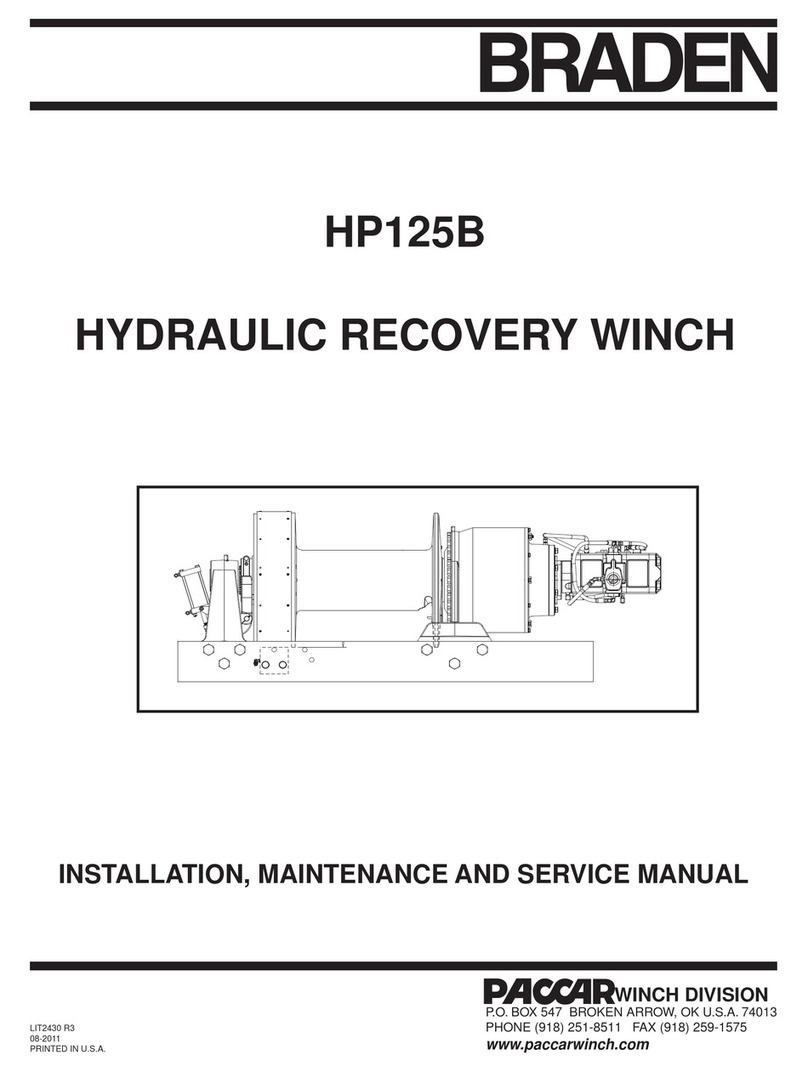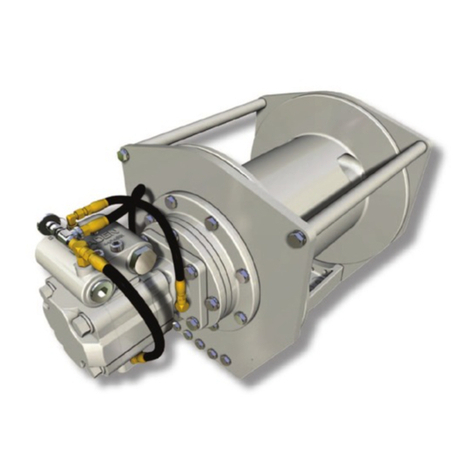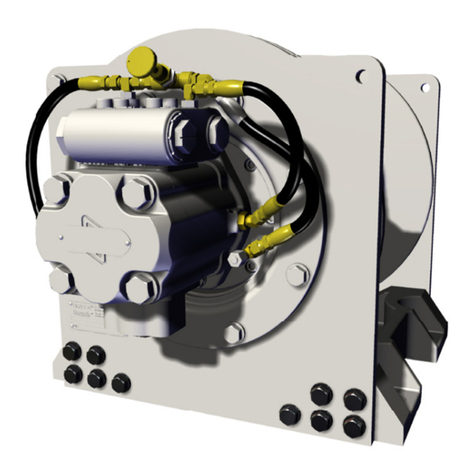Paccar Carco H200 User manual

1
LIT2753
October 2018
Printed in USA
©2018 PACCAR Inc.
All rights reserved
H200
SERVICE MANUAL
H200 Tail Winch
Visit our Web site at www.paccarwinch.com for the most comprehensive collection of winch, hoist, and drive
information on the Internet. Most publications and specification sheets are available for downloading.
WRITE WINCH SERIAL NUMBER BELOW
}
First 2 numbers indicate
year manufactured
For serial number location see page 3

2
Table of Contents
Foreword ..................................................................................................................... 2
Model Identification ..................................................................................................... 3
Explanation of Model Number..................................................................................... 4
General Safety Recommendations ............................................................................. 4
Theory of Operation .................................................................................................... 6
Preventive Maintenance............................................................................................ 10
Specifications ............................................................................................................ 11
Recommended Planetary Gear Oil ........................................................................... 12
Wire Rope Installation ............................................................................................... 13
Troubleshooting......................................................................................................... 14
H200 Major Parts Groups Cross-section .................................................................. 19
H200 Major Parts Groups Components.................................................................... 20
Service Precautions .................................................................................................. 20
Winch Removal and Installation................................................................................ 21
Winch Disassembly ................................................................................................... 22
Primary Planet Carrier Service.................................................................................. 28
Secondary Planet Carrier Service............................................................................. 29
Third Planet Carrier Service...................................................................................... 30
Output Planet Carrier Service ................................................................................... 31
Drum Clutch Assembly Service................................................................................. 32
Brake Assembly Service ........................................................................................... 34
Brake Assembly Pressure Test................................................................................. 35
Brake Valve Service.................................................................................................. 36
Overrunning Clutch Service ...................................................................................... 38
Cable Drum Service .................................................................................................. 39
Winch Assembly........................................................................................................ 41
Brake Cylinder Lifting Fixture .................................................................................... 47
FOREWORD
Managing Waste
PACCAR Winch believes in a life-cycle approach to our products. We encourage best practices regarding “Going
Green” — making environmentally responsible decisions to “reduce, reuse, and recycle.”
• At the end of the winch’s useful life, it is highly recommended to drain and recycle any oil remaining in the equipment.
• Please use a metal recycler for winch disposal to reduce landll waste.
The U.S. Environmental Protection Agency has developed required practices, called “management standards,” for busi-
nesses that handle used oil and metal wastes. Specic guidelines are available at the EPA and API Web sites as well
as your state’s environmental agency Web site:
• https://www.epa.gov/
• http://recycleoil.org/

3
This service manual has been prepared to provide maintenance information for the CARCO H200 hydraulic winches
built for use on various crawler tractors. Depending on the specic tractor hydraulics, the winches will be congured
with either variable displacement piston motors or xed displacement vane motors. When instructions apply to only one
specic winch conguration, that designation (such as variable displacement motor only) will appear at the beginning of
the related text. If not identied in this manner, the text applies to ALL H200 winches.
Read this entire publication and retain it for future reference.
For inquiries regarding your CARCO winch or this publication, please contact the CARCO Service Department at
918-251-8511, Monday through Friday, 8:00 a.m. to 4:30 p.m. (CST).
Some illustrations in this manual may show details or attachments dierent from your winch. Some components have
been removed for illustrative purposes. Drawings in this manual represent a typical unit sold through our distribution
channels. Some winches, particularly those sold directly to original equipment manufacturers, may dier in appearance
and options.
NOTE: The hydraulic motors and selected gear ratios on CARCO H200 winches are specically congured for use on
the intended tractor. The winch may not be suitable or advisable for use on anything other than the intended tractor.
Contact the CARCO Service Department with questions regarding retrotting your winch to other tractors.
FOREWORD
Model numbers, part numbers, and serial numbers
are located on the nameplate. Always refer to the
model number, part number, and serial number
when requesting information or service parts.
There is also another stamped serial number locat-
ed near the top side of winch mounting holes.
MODEL IDENTIFICATION
Safety and informational callouts used in this manual include the following Warnings and Cautions:
CAUTION – This emblem is used to warn against
potential or unsafe practices which COULD result
in personal injury and product or property damage if
proper procedures are not followed.
WARNING – This emblem is used to warn against
hazards and unsafe practice which COULD result in
severe personal injury or death if proper procedures
are not followed.
CAUTION
!
!
!WARNING !

4
Safety for operators and ground personnel is of prime
concern. Always take the necessary precautions to
ensure the safety of others as well as yourself. To ensure
safety, the tractor and winch MUST be operated with care
and concern by the equipment operator. The operator
MUST also have a thorough knowledge of the machine’s
performance capabilities.
The following recommendations are offered as a general
safety guide. Local rules and regulations also apply.
1. Read and understand ALL warning tag information,
and become familiar with ALL controls BEFORE
operating the winch.
2. NEVER attempt to clean oil or perform maintenance
on a machine with the engine or prime mover running,
unless instructed to do so in this manual.
3. Before starting the tractor, be certain all controls
move freely and are placed in the brake-on (neutral)
position.
4. NEVER operate the winch controls unless you are
properly positioned at the operator’s station, you are
sure ALL personnel are clear of the work area AND
you are properly trained in the operation of the winch.
5. Assure that personnel who are responsible for hand
signals are clearly visible and that the signals to be
used are thoroughly understood by all involved.
6. Ground personnel should stay in view of the operator
and clear of the winch drum. DO NOT allow ground
personnel near a winch line under tension. A safe
distance of at least 1-1/2 times the length of the out-
stretched cable should be maintained.
7. Avoid sudden shock loads or attempting to jerk a load
free. This type of operation may cause heavy loads, in
excess of rated capacity, which may result in a failure
of the wire rope and/or the winch.
8. Use only GENUINE CARCO parts. Do not use parts
from other winch manufacturers on your CARCO
winch. Do not use CARCO parts on winches from
other manufacturers.
9. Use correct size ferrule for cable and pocket in winch
drum. Never use knots to attach or secure cable.
The cable anchor or ferrule pocket in the cable drum
is designed to provide a self-release in the event a
backsliding load must be released from the tractor in
an emergency. The cable anchor or ferrule alone will
NOT support rated line pull. Therefore, a minimum of
five complete wraps of cable must be maintained on
the winch drum.
NOTE: We suggest painting the last five wraps of cable
bright red to serve as a visual warning.
Recommended Operating Practices
1. Wear leather gloves when handling winch cable.
2. Operate the winch to match line speeds to job condi-
tions.
GENERAL SAFETY RECOMMENDATIONS
TO ORDER:
1. List model and serial numbers of the winch.
2. Refer to cross-section drawing (exploded view), select the component(s) needed, and note item number.
3. Find item number on parts list. Show part number, description, and quantity required on your order.
4. Refer to Parts List and show price for each component or assembly.
EXPLANATION OF MODEL NUMBER
HHydraulic motor, two-speed
200 200,000-lb. first-layer line pull
500V 500:1 gear ratio
MAXIMUM
RATING
H– 200 – 500V
MOTOR GEAR
RATIO
Failure to obey the following safety recommendations
COULD result in property damage, severe personal
injury, or death if proper procedures are not followed.
!WARNING !

5
3. Assure that personnel responsible for hand signals
are clearly visible and that the signals are thoroughly
understood by everyone.
4. Inspect winch cable, rigging, winch and tractor at the
beginning of each work shift. Defects should be cor-
rected immediately.
5. Position tractor for straightest line of pull to reduce
wear on winch cable and ensure even spooling.
6. When winding winch cable on the winch drum, never
attempt to maintain tension by allowing winch cable
to slip through hands. Always use hand-over-hand
technique, being careful to keep hands and clothing
away from winch drum and fairlead rollers.
7. Be sure of tractor ground stability before winching in
a load.
8. Store unused chokers, slings, and rigging in a neat
and orderly fashion to prevent damage to equipment
or injury to personnel.
9. Do not operate the winch under loads that exceed the
maximum rated bare drum line pull. For excessive
loads, use a multipart line and sheave blocks. Any
attempt to exceed the capacity of one winch (such as
coupling two or more tractors together) is extremely
hazardous.
10. The factory-approved adaptions for CARCO winches
are designed and intended for use on specific mod-
els of crawler tractors. Changing winches between
trac- tors is not possible in some cases because of
differ- ences in tractor models. Some changes cannot
be approved by CARCO because of safety limitations.
Call a CARCO dealer or the CARCO factory prior to
attempting winch modifications or before mounting on
a different tractor.
11. CARCO H Series winches are powered by the trac-
tor hydraulic system. Discharge all retained hydraulic
system pressure before removing any hydraulic lines
or fittings. Personal injury may result from sudden
release of oil pressure.
12. To discharge the winch control system pressure, stop
the engine and cycle the winch control lever(s) into
all positions five times. Refer to the tractor manufac-
turer’s service manual for additional information.
13. On machines having hydraulically, mechanically and/
or cable controlled equipment, be certain the equip-
ment is either lowered to the ground or blocked
securely before servicing, adjusting, and/or repairing
the winch. Always apply tractor parking brakes and
lower equipment before dismounting the tractor.
14. The winches described in this manual are neither
designed nor intended for use with or application to
equipment used in the lifting or moving of persons.
15. Install guarding to prevent personnel from getting any
part of their body or clothing caught at a point where
the cable is wrapped onto the drum or drawn through
fairlead guide rollers.
16. Keep equipment in good operating condition. Perform
scheduled servicing and adjustments listed in the
Preventive Maintenance section of this manual. Use
recommended lubricants.
17. An equipment warm-up procedure is recommended
for all start-ups and essential at ambient temperatures
below +40ºF (5ºC). Refer to Warm-up Procedure
listed in the Preventive Maintenance section of this
manual.
18. Never exceed 4 mph (6.4 km/hour) relative speed be-
tween the tractor and the load while in DRIVE-AWAY
mode. This relative limit applies when the tractor and/
or the load are moving. Limiting the tractor to either
rst or second gear typically prevents reaching ex-
cessive speed only when the tractor is moving. If the
load and the tractor are moving, tractor and/or load
speed must be reduced so that relative speed does
not exceed the speed limit. Exceeding this relative
speed limit will cause the part of the winch power train
connected in DRIVE-AWAY to reach damaging back-
driven rotational speed and cause catastrophic winch
failure, damage to property connected to winch, other
property damage, personal injury, or death.
19. Drive-away should never be used with a suspended
load, such as lowering heavy equipment down a hill.
Always use the reel-out function of the winch to lower
a load.
20. The correct drum wire rope capacity (length) and
diameter are detailed in Service Bulletin Number
LIT2435 for CARCO Winches, and LIT2436 for Cat-
erpillar Winches.
21. Do not exceed the rated drum wire rope capacity of
the winch. Never use a larger wire rope diameter than
specied. Using too long of wire rope, or the wrong
size, can place excessive loads on the winch drum
and gear train. The length of tail chains, chokers, and
other end rigging count toward the maximum allow-
able rope length, so if such equipment is used, the
rope length must be adjusted accordingly.
22. Never operate the winch with the wire rope on a higher
layer than recommended. Never operate winch with
the wire rope outside the drum ange.
GENERAL SAFETY RECOMMENDATIONS
Table of contents
Other Paccar Winch manuals
Popular Winch manuals by other brands

Comeup
Comeup DV-9 manual

Orvea
Orvea Italwinch 805 Installation and user manual

Prowinch
Prowinch PWJTHF300 user manual

Clas Ohlson
Clas Ohlson LD2000-A manual

Runva
Runva EWD8000 Assembly & operating instructions

Ingersoll-Rand
Ingersoll-Rand LIFTSTAR FG 1500/CN Series Parts, operation and maintenance manual


















